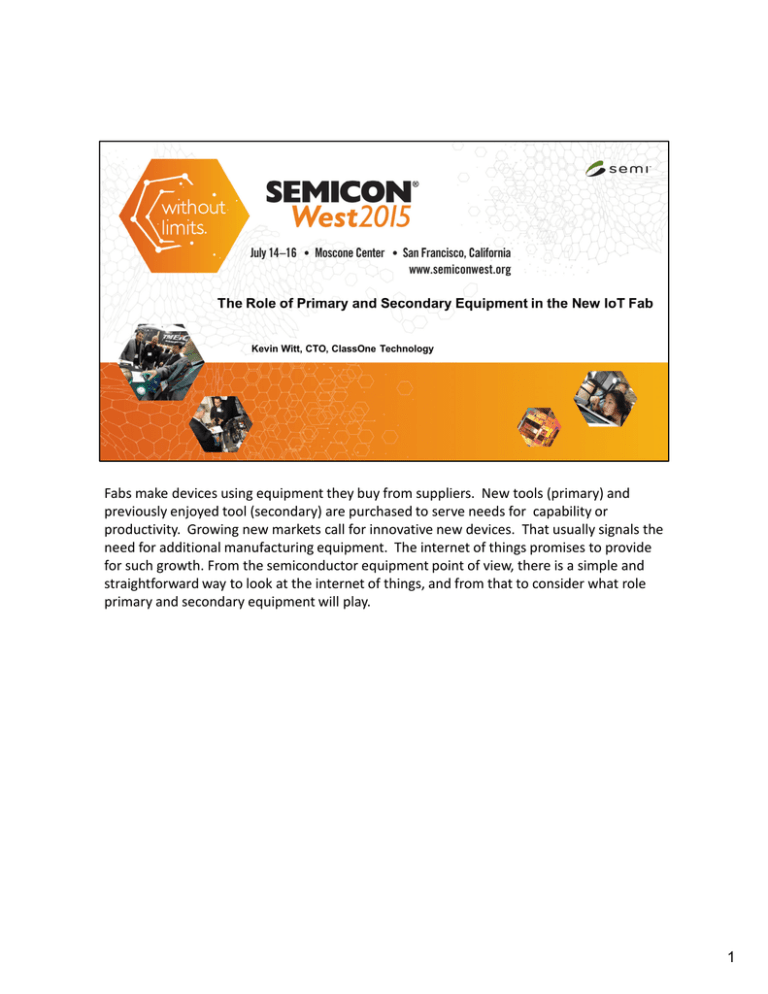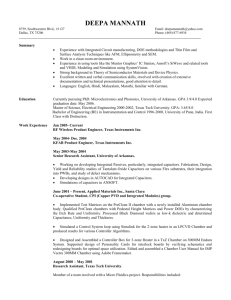Fabs make devices using equipment they buy from suppliers. New
advertisement

Fabs make devices using equipment they buy from suppliers. New tools (primary) and previously enjoyed tool (secondary) are purchased to serve needs for capability or productivity. Growing new markets call for innovative new devices. That usually signals the need for additional manufacturing equipment. The internet of things promises to provide for such growth. From the semiconductor equipment point of view, there is a simple and straightforward way to look at the internet of things, and from that to consider what role primary and secondary equipment will play. 1 Starting at the end, here is my view of what the new 200 IoT fab will look like. 2 From the equipment supplier point of view, the IOT can be broken down into two categories: The Internet, and Things. 3 For the most part, semiconductor devices that drive/support the internet appear to be a known quantity. It is made of boxes (servers, switches, routers, PC’s, tablets, phones, etc.), connected with hard communication lines (wires, cables, optical amplifiers, repeaters, fiber), storage devices (volatile and non-volatile), and displays with LED’s to look at things. There will be new and improved boxes available for replacing old ones, and new boxes going to places boxes have never been before. This is the traditional semiconductor market for Logic, Memory, Foundry, etc. which is already a huge and has seen revenues flatten out. From a growth perspective, this is not the top segment. “Things” are another matter. 4 There are two sets of “Things” to consider. “Things” we already know about that have yet to be wirelessly connected to the internet, and new “Things” that are fueling the renaissance of start-ups that will also be connected to the internet. This is both the “More than Moore” devices and the cool new “next big thing” devices likely to involve MEMs, Sensors, Energy, and/or Biotech. These are interesting things. 5 Comparatively, the annual revenue from the “Known Things” market it dwarfed by the Silicon Semiconductor market. But, this is where the growth is expected and I believe it will come from the new Interesting Things that are in development and pilot production now. 6 Distilling that down there are three areas I find interesting: The cool new devices and device capabilities that are in the pipeline integrated with the foundation of wireless connectivity. 7 And that raises the big question for equipment suppliers of all types: What are the New, Unknown, Interesting Things that will drive market growth, and hence sell more primary and secondary equipment? 8 Here’s a look back from 1993 onwards at how good we were at predicting the future. The stars represent the state-of-the-art semiconductor device manufacturing node. The lines are the ITRS prediction for the critical dimensions. 9 Moore’s law is primarily an observation of the economic underpinnings of the Semiconductor market. There have been three big knobs that have kept the industry on Moore’s technology treadmill that fuels tool sales: Device Scaling, Larger Substrates, and new materials. Let’s look at how these factors might apply to the growth on “Interesting Things” ad how that In turn drives the equipment market. 10 The first observation is that the critical dimensions of Interesting Things don’t use the cutting edge technology that drives the traditional Silicon market. 11 If anything, Interesting Things are made with p[rocesses that have dimensions consistent with Silicon several 5 to 10 nodes back, or about 15 years ago. Unfortunately given the intended market and use of the Interesting Things, they are not expected to command the margins of silicon enjoyed 15 years ago. 12 What about substrate size? Even with the dire predictions of the past, 300mm Si fabs have not taken over the entire world and replaced all the smaller substrates – even in the main Si market. Nor has compound semi gone away. Fact is, you still can’t get a 300mm SiC or GaAs wafer. Small wafers are not expected to go away. 13 Some important materials are just not available in large format substrates (affordably) and with the dominance of large silicon tools and technology, it has been difficult to justify the investment needed to develop large compound wafers. But, the resourceful manufacturers have found clever ways to make profits using smaller scale wafers So yes, 300mm Si is likely to remain the 600 pound Gorilla in the combined semiconductor market. There are, however, plenty of healthy and growing chimps that remain unaffected by 300mm and happy to use smaller wafers. 14 So, let’s take a pause and review the first two traditional market drivers and see how they apply to Interesting Things. 15 The chimps do have their critical drivers though. They have carved out a valuable and emergent space with new device types, novel combinations of new materials, and the ability to add/stack their products into “More than Moore” assemblies. I expect novel functions to drive this growth, coupled with the RF and other signal interfaces needed to connect to the IoT. 16 So let’s look at one enabling technology that allows these new Things to make it in the Si dominated world. The ability to scale packaging costs and interface with the “Internet” devices already in existence. The three trends within needed by the Chimps are the ability to reduce overall cost to manufacture, the ability to attach and interface with the traditional devices, and to meet the form factor requirements needed for multi-chip modules (MCM) and System-on-a-chip (SOC) products. 17 Electroplating of metals is a good example of how these drivers come together to drive both new materials and processes – new to the Chimps that is. Wafer level packaging is no longer just for 300mm logic and memory application. Even low end devices (as defined by the technology node of 15 years ago) have to exist in a flip-chip world and chip-stacking world. That means TSVs RDLs, Bumps and Pillars must be adopted. Gold, the traditional metallization for many compound semi devices carries to high a cost, so minimizing the amount used is mission critical. That means that combination layers of thin gold and thick Cu or Ni must be adopted. For these techniques, evaporation and sputtering will run out of steam or be too costly to consider. Adding a seed layer and electroplating through resist will replace increasingly traditional metal lift-off processes. Bottom line: Electroplating will continue to displace traditional methods of metallization – and that means equipment is needed. 18 But the Chimps don’t operate like Big Semi. They don’t run 300mm wafers at 14nm. They don’t push 10,000 to 20,000 wafers per week. But, they are maturing and modernizing, so the manual garage-shop is becoming a thing of the past. They can’t afford (in terms of cost or space) tools from the current top electroplating suppliers such as AMAT, LAM, or Nexx. Most of the time, there isn’t even a product from the big three that can run the small wafers used to make Interesting Things. Consider what a typical device maker asks for: 19 From an equipment suppliers point of view, the request boils down to a tool configuration as shown. 20 In the past few years, there have very limited options for the Chimp to consider. Those choices have various risks and price-tags associated with them that are not particularly satisfying. 21 Used equipment has been the most popular choice. But the last 12 years of equipment development has primarily been a 300mm game that has seen the advancement of plating tools. Not a lot was done on 200mm in comparison. Smaller than that was an afterthought and only a handful of tools by comparison were built. Most of those have been bought up, and the remaining units are not always well suited for the process that is needed now. 22 So the Chimps face a set of challenges if they want to succeed. They can beg the Big Suppliers to provide dumbed-down versions of their state of the art tools. They can wait until the the price brings Cindarella’s slipper to them, or they can try to find new equipment that works for them, from a supplier they can trust. 23 ClassOne is an example of a company that has a Goldilocks solution. For 13 years ClassOne has been performing high-quality, warrantied tool refurbishments with four divisions. They have established a strong reputation and built trust across the industry. This also put ClassOne in a position to see this trend and engage with these customers directly.= to learn about their needs and requirements. Again, electroplating serves as an example. 24 Here is some history from ClassOne. Over the past 8 years, small wafer equipment has dominated the company’s growth. 25 By observing first hand the trends in the secondary equipment market, ClassOne identified a gap in the market’s offerings. There was a strong need for cost-effective tools for small diameter wafers. With an ever dwindling supply of rare used electroplating tools, ClassOne saw an opportunity to develop a line of new plating tools designed for the needs of the small diameter market. Sales from the first half of 2015 support this observation: 75 to 200mm new tools are in demand! 26 Shifting to the perspective of the Chimp, the market offering of new and refurbished electroplaters can be sliced three ways: First by capacity: Tools for the Internet market that process more than 5000 wafers per week, and tool for the Interesting Things market that provide “right-sized” capacity. Next, are the tools automated or manual – essentially separating out manual wet benches. Within that division one finds three sub-groups: Cheap and cheerful, too expensive, and just right. If one groups the more reputable suppliers using this framework, for 150 and 200mm wafers one obtains this matrix. 27 But there are a lot of companies beneath the 150mm threshold that needs tools. When the same list of suppliers is considered for the smaller wafers, the field shrinks. 28 If one looks only at companies offering new tools, the field narrows further. It is this market where ClassOne leads. 29 ClassOne has developed a cost-effective product line of automated plating tool that provide a path to production for the maturing small wafer market. Priced in alignment with tools from yesteryear, but armed with toady’s advanced technology, ClassOne can answer the 100mm customer’s needs with a new, affordable, reliable electroplater configured for WLP, TSV, and exotic processes that will last to the 65nm node. 30 So, to end with the start, using electroplating as the microcosm, one can draw the following conclusions about the new 200mm IoT fab. 31

